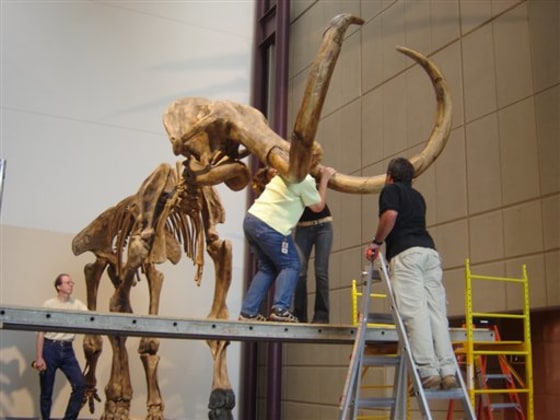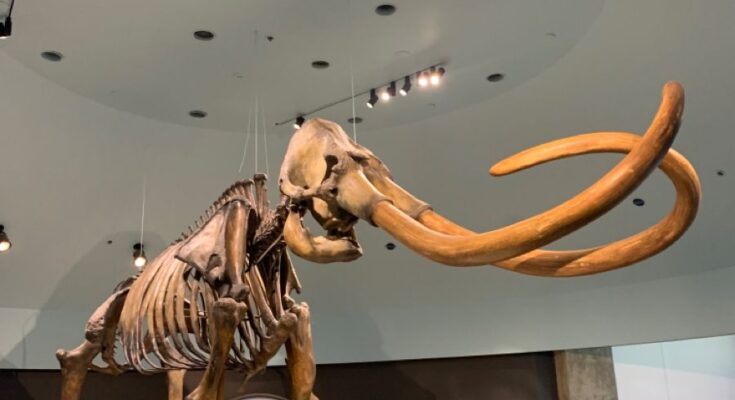Echoes of the Ice Age: Unveiling the Hebior Mammoth at the Milwaukee Public Museum

Introduction to the Woolly Mammoth: A Pleistocene Icon
The woolly mammoth (Mammuthus primigenius), an emblem of the Ice Age, roamed the northern hemispheres from about 400,000 to 4,000 years ago, adapting to cold tundras with its shaggy coat, curved tusks, and massive frame. This tutorial-style guide focuses on the captivating Hebior Mammoth exhibit at the Milwaukee Public Museum, where a striking skeleton reconstruction brings this extinct proboscidean to life. Drawing from paleontological research, we’ll explore the anatomy, discovery history, cultural significance, and evolutionary insights of this specimen. Ideal for educators, students, and enthusiasts, this post provides step-by-step methods to analyze similar fossils, interpret archaeological evidence, and understand mammoth-human interactions. By the end, you’ll be equipped to conduct your own virtual dissections or museum visits with a trained eye.
The Hebior Mammoth, discovered in 1994 in Kenosha County, Wisconsin, stands out for its near-completeness (85% intact bones) and evidence of human butchering, dating to approximately 14,500 years ago—pushing back timelines of human presence in North America. Exhibited since 2008, the skeleton is a cast replica, as the originals are too fragile for display and are preserved for research. The museum’s ground-floor setup immerses visitors in Pleistocene environments, highlighting how these giants witnessed climatic shifts and early human hunters.

Analyzing the Museum Exhibit: A Visual and Contextual Breakdown
The Milwaukee Public Museum’s Hebior Mammoth exhibit features the skeleton in a dramatic rearing pose, front limbs elevated, head thrown back, and tusks arching skyward—evoking a moment of defense or display. Mounted on a sandy platform simulating tundra terrain, the display measures about 3 meters at the shoulder, with tusks spanning up to 4 meters. Surrounding elements include interpretive panels on Ice Age ecology, artifact cases with stone tools, and adjacent exhibits like bison skulls mounted on walls, emphasizing coexisting megafauna. A scenic mural of Pleistocene landscapes—complete with clouds, mountains, and waterways—forms the backdrop, enhancing immersion.
Step 1: Assessing Overall Morphology and Pose
Start by observing the skeleton’s posture. The rearing stance, with hind limbs grounded and forelimbs pawing the air, highlights biomechanical adaptations for balance and strength. Measure proportions using digital tools or in-person calipers: The vertebral column arcs upward, supporting a skull weighing up to 200 kg. Tutorial tip: Download 3D models from sites like MorphoSource and use software like MeshLab to rotate and quantify limb lengths (hindlimbs ~2 m, forelimbs slightly shorter), inferring quadrupedal locomotion with occasional bipedal reaches for vegetation.
Step 2: Examining the Skull and Tusks
Focus on the cranium, the exhibit’s focal point. The skull features a high dome for muscle attachment, broad molars for grinding tundra grasses, and enormous tusks—modified incisors curving in a spiral for foraging, defense, or display. In the Hebior specimen, tusks show wear patterns indicative of right-handed use. Unique here are butchering marks: Scratches from stone tools on the mandible and ribs suggest human processing. Practical exercise: Compare to elephant skulls via online databases; note the mammoth’s flatter forehead and larger tusk sockets.
Step 3: Detailing the Postcranial Skeleton
Trace the axial and appendicular bones. The ribcage is expansive for a large heart and lungs, adapted to cold climates. Vertebrae number around 60, with a short neck and long tail for balance. Limbs are pillar-like, with broad feet for snow traversal. The exhibit displays the pelvis and femurs prominently, revealing robust joints. Tutorial: Sketch the skeleton and label elements (e.g., scapula, humerus); use biomechanics apps to simulate movement, estimating speeds of 25-40 km/h.

Scientific Background: Discovery and Research Timeline
The Hebior Mammoth’s story began in 1979 with a bone find on John Hebior’s farm, but full excavation occurred in the 1990s by Marquette University archaeologists. Dated to 14,500 years BP via radiocarbon, it predates Clovis culture, challenging migration models.
Step 4: Tracing Excavation Processes
Excavations involved grid mapping and plaster jacketing to protect bones. Artifacts like quartzite choppers confirmed human involvement. Replicate this: Study field notes from similar sites; use GIS software to plot discovery locations relative to ancient lakeshores.
Step 5: Interpreting Butchering Evidence
Examine cut marks under microscopy—linear grooves from flaked tools indicate skinning and meat removal. This evidence supports pre-Clovis habitation. Tutorial: Analyze photos with image enhancement tools like GIMP to highlight marks; compare to experimental archaeology studies.
Detailed Anatomical Changes: Evolutionary Adaptations
Woolly mammoths evolved from steppe mammoths, developing insulation and smaller ears for heat retention.
Step 6: Mapping Skeletal Adaptations
- Tusks and Dentition: Tusks grew continuously; molars replaced six times in life for abrasive diets.
- Limb Structure: Columnar legs distributed 5-6 ton weight; compare ratios (femur:tibia ~1:1) to modern elephants.
- Vertebral Column: Flexible for trunk movement; count caudals (~20) for tail length.
Use calipers on models to calculate allometry.
Histological and Paleopathological Insights
Bone thin sections reveal growth rings, estimating age at death (40-50 years for Hebior).
Step 7: Analyzing Microstructures
Prepare virtual slides: Identify Lines of Arrested Growth (LAGs) for seasonal stress; note vascularity indicating rapid growth.
Implications for Paleobiology and Human History
The Hebior specimen links mammoths to early humans, suggesting hunting contributed to extinctions amid climate change.
Step 8: Extending to Broader Contexts
Apply to other sites like the Schaefer Mammoth; debate overkill vs. climate hypotheses using data models.
Conclusion: Preserving Prehistoric Legacies
The Hebior Mammoth exhibit at the Milwaukee Public Museum not only showcases anatomical marvels but also bridges ancient ecosystems to modern conservation. By following these analytical steps, you can deepen your understanding of paleontology. Plan a visit or explore virtual tours for hands-on learning. This knowledge illuminates how Ice Age giants shaped our world, urging reflection on biodiversity today.



